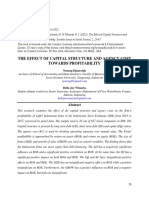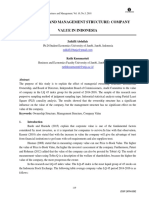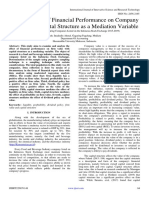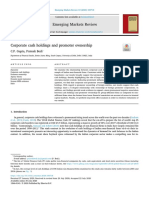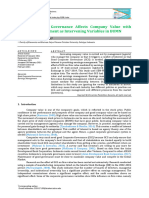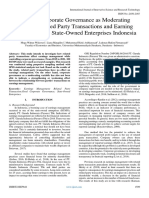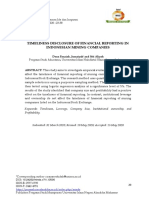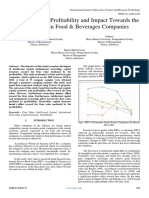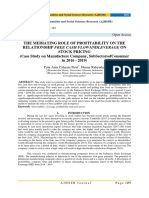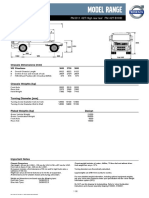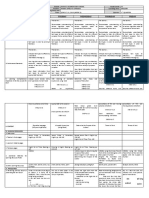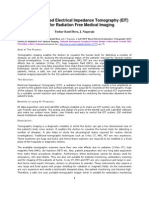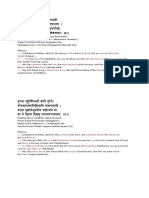Professional Documents
Culture Documents
Role of Political Connections and Family Ownership To Related Party Transactions in Indonesia
Original Title
Copyright
Available Formats
Share this document
Did you find this document useful?
Is this content inappropriate?
Report this DocumentCopyright:
Available Formats
Role of Political Connections and Family Ownership To Related Party Transactions in Indonesia
Copyright:
Available Formats
Volume 8, Issue 2, February – 2023 International Journal of Innovative Science and Research Technology
ISSN No:-2456-2165
Role of Political Connections and Family
Ownership to Related Party Transactions in Indonesia
Fuad Hudaya Fatchan1, Ilham Nuryana Fatchan 2
1
Faculty of Economics and Business, Universitas Muhammadiyah Surakarta, Surakarta – Indonesia
2
Faculty of Economics and Business, Universitas Muhammadiyah Purwokerto, Purwokerto - Indonesia
Abstract:- A related party transaction is a transfer of has the ability to influence the financial and operating policies
resources, services or obligations between the reporting of the investee through the presence of control, joint control or
entity and related parties, regardless of whether a price is significant influence. Kang, Lee, Lee & Park (2014) state that
charged. There are several factors that can influence RPT is a transfer of resources, services, or obligations from a
abusive or efficient related party transactions, namely reporting entity to related parties, which usually refers to
family ownership and political connections. This study executives, boards of directors, and major shareholders .
discusses the effect of family ownership and political
connections on related party transactions with control Kohlbeck & Mayhew (2010) stated that RPT can
variables, namely audit quality, firm size, profitability and categorized into 2 namely RPT which has a positive impact or
firm age. This research focuses on mining companies listed efficient transaction if RPT can be used as an efficient and
on the Indonesian stock exchange in 2016-2020 with a profitable contract mechanism for companies to achieve
research sample of 170 companies. Data analysis used shareholder value maximization by reducing transaction costs
Eviews 9 with the Random Effect Model test. The results thereby achieving good economies of scale for the company.
of the study show that family ownership and political RPT can be a management effort to improve company
connections have an effect on related party transactions. performance (Williamson, 1975; Stein, 1997)
Control variables are audit quality, company size,
company age effect on related party transactions. Conversely, the second RPT is detrimental (abusive
Profitability has no effect on related party transactions. RPT) if the related party transaction is used to manipulate the
company's operating results for economic gain which only
Keywords:- Related Party Transactions, Family Ownership, benefits the company's majority shareholder. Yeh, Shu & Su
Political Connections, Audit Quality, Company Size, (2012) state that a detrimental RPT is the appropriation of
Profitability, Company Age. wealth from minority shareholders by majority/ controlling
shareholders.
I. INTRODUCTION
The ownership structure in Indonesia is the same as other
The company's financial statements aim to provide Asian countries which have a concentrated ownership
information regarding the financial position, financial structure in one group such as the family or the state. In
performance and cash flows of entities that are useful to most Indonesia with a concentrated ownership pattern and the main
users of financial statements in making economic decisions owner The dominant (ultimate control) is the family (Arifin,
(statement of financial accounting standart/PSAK No. 1, 2018, 2003). Previous research in Indonesia found that RPT
Paragraph 09). Information contained in a company's financial transactions are in line with family ownership (Barokah, 2013;
statements can be useful if it is presented in a transparent, Dyanty et al 2013). According to a survey conducted by Price
accurate and timely manner when needed by Waterhouse Cooper (PWC ) in 2014, more than 95 percent of
shareholders/creditors and potential investors/creditors to companies in Indonesia are family businesses. Claessen et al.
assess the company's financial condition, as well as the (1999) found that more than 50% of companies in Indonesia
company's going concern, as a basis for decision-making. One are controlled by families.
of the information presented in the report corporate finance is
information about related party transactions or related party Company impact family control on RPT can be explained
transactions (RPT). by entrenchment or alignment effects. The entrenchment
effect is defined as the ability of the ultimate controlling
In Indonesia, RPT is based on statements of financial shareholder to determine the company's operational policy in
accounting standards number 7 of 2014 concerning disclosure accordance with his personal interests, even if he has to
of related parties. A related party transaction is a transfer of sacrifice the interests of the shareholders and other
resources, services or obligations between the reporting entity stakeholders. When the entrenchment effect dominates, family
and related parties, regardless of whether a price is charged. ownership encourages related party transactions to strengthen
According to IAS 24, the RPT relationship is activity normal motivation to expropriate through related party transactions
activities of commerce and business. For example, an entity because control is in the hands of one family controller
often carries out some of its activities through subsidiaries, (Dyanty, 2013). Hu et al (2012) state that there is a lot of
joint ventures and associates. In such circumstances, the entity information owned by family ownership as the controlling
IJISRT23FEB107 www.ijisrt.com 288
Volume 8, Issue 2, February – 2023 International Journal of Innovative Science and Research Technology
ISSN No:-2456-2165
shareholder. Transactions carried out by controlling shares can on firm value. Habib et al. (2017) found that there was a
be used as a means to carry out expropriation of company positive effect political connections to related party
resources which can harm minority shareholders due to transactions. Connected company politics will do RPT. In
tunneling carried out by controlling shareholders. contrast, Abdullatif et al.'s research. (2019) stated Jordan
found that there was no influence between political
Furthermore, the alignment effect occurs when low connections and related party transactions.
family ownership encourages related party transactions to
increase firm value through low costs and effective control so II. RESEARCH METODS
that these transactions can provide benefits for business
development (Fan & Goyal, 2006). Anderson and Reeb (2003) The population of this study are mining sector companies
emphasize that family firms pay more attention to reputation listed on the Indonesia Stock Exchange (IDX) in 2016-2020.
than non-family firms because families expect a continued Selection of the sample using purposive-sampling with
presence in the companies they start. criteria:
Researchers obtain the complete annual reports of mining
Previous research on RPT with family ownership. sector companies from 2016 to 2020 through the official
Cheyoong et al (2015) examined Malaysian companies using websites of each company and on the official website of
panel data stating that RPT in family firms reduces firm value, the Indonesia Stock Exchange (www.idx.go.id)
expropriation through RPT is stronger in family firms Companies that include information related to research
compared to non-family firms. Azim et al (2018) examined the variables in their annual reports.
main shareholders of Pakistani family-owned companies who
took over resources through RPT. The results of the study A. Research variable
concluded that there is a relationship between the
concentration of family shareholders and the exploitation of Related Party Transactions (RPT)
the interests of minority shareholders. This is supported by the In this study, the dependent variable used is related party
research of Mohammed (2019) and Dyanty et al (2013) which transactions (RPT) as seen from the sum of the total RPT sales,
state that RPT will be stronger with family ownership. In RPT purchases, RPT debt and RPT receivables divided by
Berto's research (2019) ownership was reported to have a total assets. The use of these transactions has contributed
positive effect on tunneling. That is, the more concentrated the significantly to the business operations of companies in
shareholders are in accordance with indications of Indonesia.
expropriation. Likewise Abdullatif et al (2019) stated that
companies with high concentration of ownership can use RPT This measurement was chosen because, related party
in tunneling activities to take over funds to dominant transactions have been regulated in PSAK 7 and OJK
shareholders. regulations through Regulation number VIII.G.7 concerning
guidelines for presenting financial statements, one of which
In contrast, Bansal & Thenmozhi (2020) find that has points, namely (a) The company provides details of total
concentrated founder ownership in India is more likely to drive assets, liabilities, sales , and purchase of RPT; (b) The
RPTs that are beneficial to minority shareholders compared to company assigns a percentage value in point (1) to total assets,
RPTs that lead to takeovers. Alhadab et al (2020) which liabilities, sales and purchases; (c) The company provides
showed that there was no effect of family ownership on the debt/receivable values from RPT that are not related to the
RPT relationship. company's main business activities (Nuritomo et al, 2020).
Majority share ownership has an interest in carrying out RPT
RPT activities with political connections to get protection in RPT Sales + RPT Purchases + RPT Debt + RPT Receivables
=
these activities. Agency theory is the theory that underlies the Total Assets
linkages between connections policies and related party
transactions. This theory leads to the linkage of the Family Ownership
relationship between majority shareholder and minority The family ownership structure is defined as share
shareholder. Having political connections exacerbate type II ownership owned by the family, or the family has an important
agency conflict in which the majority shareholder takes role in the management of the company, so that the aims and
advantage position in the company for their own interests interests of the family are . Bertnard and Schoar (2006) suggest
without prioritizing the shareholders minority shares that family firms are characterized by concentrated ownership,
(Villalonga & Amit, 2006). According to (Ling et al, 2016) control and the presence of one or several family members
stated from the perspective of agency theory, companies that occupying executive positions. For measuring family
are politically connected have the potential to be RPT . ownership using a dummy by looking at the percentage
according to PSAK No. 15 whose measurement uses a
Several previous studies have examined the influence percentage of 20% share ownership.
between political connections and related party transactions.
Ismail et al (2022) researched that many Egyptian companies Political Connections
are still connected to political boards of directors and political The political connection variable will use 2 indicators,
relations have a significant effect on RPT. Supatmi et al (2021) namely aspects of political ownership owned by independent
stated that political connections strengthen the effect of RPT commissioners and independent commissioners, with criteria,
namely concurrent positions as politicians affiliated with
IJISRT23FEB107 www.ijisrt.com 289
Volume 8, Issue 2, February – 2023 International Journal of Innovative Science and Research Technology
ISSN No:-2456-2165
political parties, concurrent positions as government officials, is able to compete in getting business opportunities
concurrent positions as military officials, and former officials (Sembiring, 2012). In addition, the age of the company also
government or former military officials (Fan, 2007 in Pranoto affects the efficiency of the company in carrying out its
Ari, 2014) in. Political connection is measured by a dummy operational activities. In this study, the age of the company
variable. A dummy variable is an artificial variable or dummy will be calculated from the year the company was founded
variable created to quantify qualitative data by giving a code of until the year the observations were made.
0 (zero) or 1 (one) (Main, 2007 : 97 in Dharma and Putu, 2016) Company Age = year of observation - year of company
in (Purwanti & Sugiyarti, 2017) establishment
Audit Quality Profitability
Audit quality is the size of the Public Accounting Firm Profitability in this study is proxied by return on assets
used by the company in examining the company's financial (ROA). Return On Assets (ROA) used to measure
statements. The measurement of the Public Accounting Firm management's ability to earn overall profits. The higher the
size variable in this study uses a dummy variable with the ROA owned by a company, the more efficient use of assets
provision that companies that use big four Public Accounting will be increase profits (Madli, 2014). Return on total assets
Firms are given a score of 1 and companies that use non- big (ROA) is calculated by comparing the net profit after interest
four Public Accounting Firms are given a score of 0 ( and taxes with total assets with the following formula:
Abdullatif et al, 2019).
Net Profit after Interest and Tax
Size ROA =
Total Assets
This research includes size or company size as a control
variable. Company size is an important factor indicating that B. Research Frameworks
large companies are relatively more stable and able to provide
benefits compared to companies with smaller sizes. The
natural logarithm value of the converted total assets. Size has
been widely used in disclosure research as a control variable
(Hamid et al, 2016). In this study everything was converted
into rupiah and in accordance with the rupiah currency that
was in effect at the time this research was conducted.
Company Age
According to Lee and Choi (2015) the longer the period
of time a company is registered, the higher the possibility that
the company has long-term investment decisions and high
corporate value. Through the age of the company, investors Fig 1 Research Frameworks
can see whether a company is able to continue to survive and
III. RESULTS AND DISCUSSION
A. Research Sample
Table 1 . Research Sample
No Criteria Samples
1 Number of mining companies period 2016-2020 (38 mining companies multiplied by 5 years) 190
2 Number of mining companies in 2010 -2020 who do not present financial reports (not found) 20
Number of final sampled used 170
B. Descriptive Statistics
Table 2. Descriptive Statistics
RPT POL FAM KAP SIZE AGE ROA
Mean 0.063407 0.458824 0.340142 0.476471 20.16222 29.15294 1.790964
Median 0.019613 0.000000 0.317600 0.000000 20.23250 27.50000 0.826000
Maximum 0.930607 1.000000 0.925000 1.000000 29.05046 52.00000 43.48400
Minimum 0.000000 0.000000 0.000000 0.000000 14.65477 4.000000 -153.8300
Std. Dev. 0.124243 0.499774 0.294679 0.500922 2.304949 12.30000 16.05218
N 170 170 170 170 170 170 170
Description: * indicates a significance of 5%; RPT = Accounts payable, receivables, sales and purchases related party
transactions; POL = political connections to company directors or commissioners; FAMILY = Percentage of family share
ownership; KAP = Audit quality; SIZE = Company size; AGE = Age of the company; ROA = company profitability level.
IJISRT23FEB107 www.ijisrt.com 290
Volume 8, Issue 2, February – 2023 International Journal of Innovative Science and Research Technology
ISSN No:-2456-2165
Related party transactions (RPT) as measured using the C. Hypothesis testing
sum of related party transactions of sales, purchases, payables Table 3 shows the results of panel data regression testing
and receivables divided by total assets in this study have an using a random effect research model . To test the hypothesis
average of 0.063 with a maximum and minimum value of formulated as follows:
0.930 and 0, respectively. Related party transactions with a
maximum value of 0.930 indicates that the level of related RPT= a + ß1POL+ ß2FO + ß3AQ + ß4SIZE + ß5AGE +
party transactions practiced is high, around 93%. This ß6ROA + e
indicates that the sample firms In this study, the practice of
related party transactions is carried out from several aspects of RPT = Related Party Transaction
transactions such as debts and receivables to achieve certain a = Konstanta
goals. However, there are also those who do not conduct POL = Politic Connection
transactions with related parties in certain years . FO = Family Ownership
AQ = Audit Quality
Family ownership of mining companies in Indonesia is SIZE = Company Size
34.0%. As is known according to PSAK No. 15 regarding AGE = CompanyAge
share ownership, that investors are considered to have ROA = Profitability
influence significant if owning either directly or indirectly e = Error
through the company's shareholding 20% or more of the
investee 's voting rights . It can be concluded that the majority
of mining companies in Indonesia are owned by families.
Table 3. Hypothesis testing
Dependent Variable: RPT
Variable Coefficient Std. Error t-Statistic Prob.
C 0.116119 0.048160 2.411118 0.0170
POL 0.042323 0.016625 2.545687 0.0118*
FAM 0.038021 0.017670 2.151769 0.0329*
KAP -0.027518 0.010835 -2.539738 0.0120*
SIZE -0.005818 0.002610 -2.229085 0.0272*
AGE 0.001242 0.000316 3.927507 0.0001*
ROA -3.23E-05 0.000456 -0.070859 0.9436
Adjusted R-squared 0.056988
F-statistic 2.682021
Prob(F-statistic) 0.016537*
N (Observations) 170 170 170 170
Description :* indicates a significance of 5%; RPT = Accounts payable, receivables, sales and purchases related party
transactions; POL = political connections to company directors or commissioners; FAMILY = Percentage of family share
ownership; KAP = Audit quality; SIZE = Company size; AGE = Age of the company; ROA = company profitability level.
The influence of political connections on the RPT The results of this study are consistent with research conducted
The test results in table 3 show that political connections by Azim et al (2018), Amzaleg & Barak (2011), Mohammed
have a positive effect on RPT with a value of 0.0118, which (2019), Cheyoong et al (2015), Kohlbeck et al (2018), Munir
means that it has a significant effect on RPT. The research (2011), Berto (2019) ), Abdullatif et al (2019), Ernawati &
results are consistent with research conducted by Ismail et al Aryani (2019).
(2022), Supatmi et al (2021), Habib et al (2017) and Rahman
& Nugrahanti (2021) Family ownership has proven to be more encouraging for
the magnitude of related party transactions. Family ownership
Ismail et al (2022) stated that many Egyptian companies of the controlling shareholder has proven to strengthen
are still connected to political boards of directors and political motivation to engage in related party transactions. This is very
relations have a significant effect on RPT. Supatmi et al (2021) reasonable because if there are several companies (company
state that political connections strengthen the RPT effect on groups) in the hands of one family controller, the family's
company value. Habib et al. (2017) and Rahman & Nugrahanti wealth is spread over many companies. These conditions will
(2021) state that there is a political connection can be used to allow for expropriation through related party transactions
practice RPT through related party transactions committed by (Dyanty et al, 2012). Family controlled companies have low
the majority shareholder against the minority shareholder . motivation to disclose related party transactions. This result
can be an indication that the family as the controlling
The effect of family ownership on RPT shareholder takes advantage of related party transactions
Table 3 shows the results statistical test that the value of (Ernawati & Aryani, 2019)
family ownership is 0.0329 which means family ownership
has a significant positive effect on related party transactions.
IJISRT23FEB107 www.ijisrt.com 291
Volume 8, Issue 2, February – 2023 International Journal of Innovative Science and Research Technology
ISSN No:-2456-2165
Effect of Public Accounting Firm, Size, Company age and [3]. Alhadab, M., Abdullatif, M., & Mansour, I. (2020).
Profitability on RPT Related Party Transactions and Earnings Management
Table 3 shows that the audit quality control variable has in Jordan: the role of ownership structure. Journal of
an effect on RPT with a value of 0.012. Company size has a Financial Reporting and Accounting, 18(3), 505–531.
probability value of 0.027 which means it has an effect on https://doi.org/10.1108/JFRA-01-2019-0014
RPT. The age of the company has a value of 0.000, so it affects [4]. Ali, A., T. Chen, dan S. Radhakrisnan. (2007).
the RPT. Conversely, the profitability variable measured using Corporate Disclosure by Family Firms. Journal of
ROA has no effect on RPT because it has a value of 0.9436 Accounting and Economics, Vol. 44: 238-286.
which is above 0.05 [5]. Al-Najjar, B., & Kilincarslan, E. (2016). The Fffect of
Ownership Structure on Dividend Policy: Evidence
IV. CONCLUSION from Turkey. Corporate Governance (Bingley), 16(1),
135–161. https://doi.org/10.1108/CG-09-2015-0129
A. Conclusion [6]. Amzaleg, Y., & Barak, R. (2012). Ownership
This study aims to examine the relationship between Concentration and the Value Effect of Related Party
political connections and family ownership of related party Transactions. SSRN Electronic Journal, November.
transactions in mining companies in 2016-2020 . The data https://doi.org/10.2139/ssrn.1959557
analysis conducted shows that the average family ownership [7]. Ancella Anitawati Hermawan. (2011). The Influence
of mining companies in Indonesia is 34.0%. As is known of Effective Board of Commissioners and Audit
according to PSAK No. 15 regarding share ownership, that Committee on The Informativeness of Earnings:
investors are considered to have influence significant if Evidence Indonesian Listed Firm, Asia Pasific Journal
owning either directly or indirectly through the company's of Accounting and Finance, Vol.2, Issue 1.
shareholding 20% or more of the investee's voting rights . It [8]. Anderson, R. C. & Reeb, D. M. (2003). Founding-
can be concluded that the majority of mining companies in family ownership and firm performance: evidence from
Indonesia are owned by families. the S&P 500. The Journal of Finance, 58 (3),1301-
1328.
The results of the study show that family ownership has [9]. Annisa Harijanto, V. N. (2019). Pengaruh Struktur
a significant positive effect on related party transactions. Ali Kepemilikan dan Ukuran Kantor Akuntan Publik
et al. (2007) stated that family firms suffer less from type I terhadap Tingkat Kepatuhan Pengungkapan Transaksi
agency problems than type II agency problems as a Berelasi Berdasarkan PSAK No 7 Tentang
consequence of highly concentrated ownership which gives Pengungkapan Pihak-Pihak Berelasi. Nominal:
them strong incentives and the ability to maximize their Barometer Riset Akuntansi Dan Manajemen, 8(1), 59–
interests at the expense of minority shareholders. Furthermore, 70. https://doi.org/10.21831/nominal.v8i1.24499
the results of the study show that political connections have a [10]. Apriyani, H. W. (2016). Pengaruh Corporate
positive effect on RPT. The results are consistent with research Governance dan Karakteristik Perusahaan Terhadap
conducted by Ismail et al (2022), Supatmi et al (2021), Habib Luas Pengungkapan Transaksi Pihak Berelasi di
et al (2017) and Rahman & Nugrahanti (2021) Indonesia. Jurnal Akuntansi Indonesia, 4(1), 36.
https://doi.org/10.30659/jai.4.1.36-50
B. Suggestion [11]. Ariff, A. M., & Hashim, H. A. (2013). The Breadth and
This research has several limitations. First, this research Depth of Related Party Transactions Disclosures.
only focuses on mining companies in Indonesia. Based on this, International Journal of Trade, Economics and
further research needs to explore more broadly by taking Finance, June, 388–392.
samples of other corporate sectors in Indonesia. Second, it is https://doi.org/10.7763/ijtef.2013.v4.323
hoped that future research will focus on the sample data that [12]. Arifin, Z. (2003). Masalah Agensi dan Mekanisme
will be examined, namely family ownership, because in this Kontrol pada Perusahaan dengan Struktur Kepemilikan
study the researchers did not focus on family ownership of Terkonsentrasi yang Dikontrol Keluarga: Bukti dari
mining companies in Indonesia, but used data on all mining Perusahaan Publik di Indonesia. Disertasi. Depok:
companies in Indonesia. Universitas Indonesia.
[13]. Azim, F., Mustapha, M. Z., & Zainir, F. (2018). Impact
REFERENCES of Corporate Governance on Related Party
Transactions in Family-Owned Firms in Pakistan.
[1]. Agnihotri, A., & Bhattacharya, S. (2019). Institutions and Economies, 10(2), 22–61.
Internationalization, Related Party Transactions, and [14]. Azwari, P. C. (2016). Masalah Keagenan pada Struktur
Firm Ownership Structure: Empirical evidence from an Kepemilikan Perusahaan Keluarga di Indonesia.
emerging market. Research in International Business Akuntabilitas: Jurnal Ilmu Akuntansi, 9(2), 173–184.
and Finance, 48, 340–352. https://doi.org/10.15408/akt.v9i2.4021
https://doi.org/10.1016/j.ribaf.2019.02.004 [15]. Bambang, M., & Hermawan, M. S. (2013). Founding
[2]. Agoes, Sukrisno, I Cenik Ardana. (2009). Etika Bisnis Family Ownership and Firm Performance in Consumer
dan Profesi: Tantangan Membangun Manusia Goods Industry: Evidence from Indonesia. SSRN
Seutuhnya. Jakarta : Salemba Empat. Electronic Journal, 4(2), 112–131.
https://doi.org/10.2139/ssrn.2292375
IJISRT23FEB107 www.ijisrt.com 292
Volume 8, Issue 2, February – 2023 International Journal of Innovative Science and Research Technology
ISSN No:-2456-2165
[16]. Bansal, S., & Thenmozhi, M. (2020). Does from connected party transactions in Hong Kong.
Concentrated Founder Ownership Affect Related Party Journal of Financial Economics, 82, 343-386.
Transactions? Evidence from an Emerging Economy. [31]. Cheung, YL, Jing, L, Lu, T, Rau, P. R. and Stouraitis,
Research in International Business and Finance, 53, A. 2009. Tunneling and propping up: An analysis of
101206. https://doi.org/10.1016/j.ribaf.2020.101206 related party transactions by Chinese listed companies,
[17]. Barokah, Z. (2013). an Analysis of Corporate Related- Pacific-Basin Finance Journal, 17(3):372-393
Party Disclosure in the Asia-Pacific Region. [32]. Claessens et al (1999), The separation of ownership
Disertation, Queensland University of Technology, 1– and control East Asia Corporations, Wiley for the
214. American Finance Association Stable
[18]. Barontini, R., Bozzi, S., 2012. CEO Compensation and [33]. Claessens, S., S. Djankov, J. P. H. Fan, dan L. H. P.
Performance in Family Firms. Working Paper, Scuola Lang. (2002). Disentangling the Incentive and
Superiore Sant’Anna, Pisa. Entrenchment Effects of Large Shareholdings. The
[19]. Benjamin Maury, (2006), Family ownership and firm Journal of Finance. 57 (6). 2741-2771.
performance: Empirical evidence from Western [34]. De Cesari, A. (2012). Expropriation of Minority
European corporations, Journal of Corporate Shareholders and Payout Policy. British Accounting
Finance, 12, (2), 321-341 Review, 44(4), 207–220.
[20]. Bernard, A. B., Jensen, J. B., and Schott, P. K. 2006. https://doi.org/10.1016/j.bar.2012.09.002
Transfer pricing by u.s.- based multinational rms. [35]. Diyanti, V., Utama, S., Rossieta, H., & Veronica, S.
NBER Working Papers 12493, National Bureau of (2013). Pengaruh Kepemilikan Pengendali Akhir,
Economic Research, Inc Kepemilikan Keluarga serta Praktek Corporate
[21]. Bona-sánchez, C., Fernández-senra, C. L., & Pérez- Governance Terhadap Transaksi Pihak Berelasi dan
alemán, J. (2016). Related-Party Transactions, Kualitas Laba. Simposium Nasional Akuntansi XVI,
Dominant Owners and Firm Value. Analytica Chimica I(March 2019), 213–247.
Acta, 11–21. https://doi.org/10.1016/j.brq.2016.07.002 [36]. Diyanty, V. (2016). Efek Entrenchment dan Alignment
[22]. Carsrud, A.L., (2004). Meanderings of a Resurrected Pengendali Akhir Keluarga dan Peran Dewan
Psychologist or, Lessons Learned in Creating a Family Komisaris Terhadap Biaya Utang. 1–22.
Business Program. Entrepreneurship: Theory and [37]. Duygun, M., Guney, Y., & Moin, A. (2018). Dividend
Practice (19: pp. 40-50) Policy of Indonesian Listed Firms: The Role of
[23]. Chee Yoong, L., Alfan, E., & Devi, S. S. (2015). Families and the State. Economic Modelling,
Family Firms, Expropriation and Firm Value: Evidence 75(October 2017), 336–354.
from Related Party Transactions in Malaysia. The https://doi.org/10.1016/j.econmod.2018.07.007
Journal of Developing Areas, 49(5), 139–152. [38]. El-Helaly, M. (2018). Related-Party Transactions: A
https://doi.org/10.1353/jda.2015.0048 Review of the Regulation, Governance and Auditing
[24]. Chen, C., & Wu, C. (2010). Related Party Transactions Literature. Managerial Auditing Journal, 33(8–9),
and Ownership Concentration: Theory and Evidence. 779–806. https://doi.org/10.1108/MAJ-07-2017-1602
E-Leader Conference, 57, 1–8. http://www.g- [39]. Ernawati, D., & Aryani, Y. A. (2019). Controlling
casa.com/conferences/singapore/papers_in_pdf/wed/C Shareholders , Audit Committee Characteristics , and
hen.pdf Related Party Transaction Disclosure : Evidence From
[25]. Chen, Y., Wang, Y., & Lin, L. (2014). Independent Indonesia Article history : 23(1), 14–28.
Directors’ Board Networks and Controlling [40]. Ferdi, F., & Rossieta, H. (2019). The Effect of
Shareholders’ Tunneling Behavior. China Journal of Institutional Ownership on Disclosure of Related Party
Accounting Research, 7(2), 101–118. Transactions: Empirical Evidence from Indonesian
https://doi.org/10.1016/j.cjar.2013.09.002 Publicly Listed Companies. 89(Apbec 2018), 313–317.
[26]. Chen, Z., Cheung, Y.-L., Stouraitis, A., & Wong, A. https://doi.org/10.2991/apbec-18.2019.41
W. S. (2005). Ownership concentration, firm [41]. Fooladi, M., & Farhadi, M. (2019). Corporate
performance, and dividend policy in Hong Kong. Governance and Detrimental Related Party
Pacific-Basin Finance Journal, 13(4), 431– Transactions: Evidence from Malaysia. Asian Review
449. doi:10.1016/j.pacfin.2004.12.001 of Accounting, 27(2), 196–227.
[27]. Chen, Z., Y., Cheung, A. Stouraitis, and A.W.S. Wong, https://doi.org/10.1108/ARA-02-2018-0029
2005, “Ownership Concentration, Firm Performance, [42]. Ghozali, I.(2016. Aplikasi Analisis Multivariate
and Devidend Policy in Hong Kong”, Pasific-Basin dengan Program IBM SPSS 23. Semarang: BPFE
Finance Journal, 13,431-449. Universitas Diponegoro.
[28]. Cheng, Q. (2014). Family Firm Research - A review. [43]. Gordon, Elizabeth A.; Henry, Elaine; Palia, Darius
China Journal of Accounting Research, 7(3), 149–163. (2004). Related Party Transactions: Associations with
https://doi.org/10.1016/j.cjar.2014.03.002 Corporate Governance and Firm Value. SSRN
[29]. Cheng, S., Firth, M., (2006), Family Ownership, Electronic Journal, (), doi:10.2139/ssrn.558983
Corporate Governance, and Top Executive [44]. Habib, A., Muhammadi, A. H., & Jiang, H. (2017).
Compensation. Wiley InterScience Vol. 27, 549-561 Political Connections and Related Party Transactions:
[30]. Cheung, S. Y., Rau, P.R. and Stouraitis, A. 2006. Evidence from Indonesia. International Journal of
Tunnelling, propping and expropriation: Evidence Accounting, 52(1), 45–63.
https://doi.org/10.1016/j.intacc.2017.01.004
IJISRT23FEB107 www.ijisrt.com 293
Volume 8, Issue 2, February – 2023 International Journal of Innovative Science and Research Technology
ISSN No:-2456-2165
[45]. Haji-Abdullah, N. M., & Wan-Hussin, W. N. (2015). [59]. Kaihatu, T. S. 2006. Good Corporate Governance dan
Related Party Transactions, Audit Committees and Penerapannya di Indonesia. Jurnal Manajemen dan
Real Earnings Management: The Moderating Impact of Kewirausahaan, Vol. 8, No.1 : 1-9, Maret.
Family Ownership. Advanced Science Letters, 21(6), [60]. Kang, M., Lee, H. Y., Lee, M. G., & Park, J. C. (2014).
2033–2037. https://doi.org/10.1166/asl.2015.6195 The Association between Related-Party Transactions
[46]. Hamid, M. A., Ting, I. W. K., & Kweh, Q. L. (2016). and Control-Ownership Wedge: Evidence from Korea.
The Relationship between Corporate Governance and In Pacific Basin Finance Journal (Vol. 29). Elsevier
Expropriation of Minority Shareholders’ Interests. B.V. https://doi.org/10.1016/j.pacfin.2014.04.006
Procedia Economics and Finance, 35(16), 99–106. [61]. Kohlbeck, M. J., Lee, H. S., Mayhew, B. W., & Salas,
https://doi.org/10.1016/s2212-5671(16)00014-9 J. M. (2018). The Influence of Family Firms on Related
[47]. Helena, R., Firmansyah, A., (2018). Pengungkapan Party Transactions and Associated Valuation
Pihak-Pihak Berelasi pada Perusahaan-Perusahaan Implications. SSRN Electronic Journal, 33431(561).
Salim Group yang Terdaftar di Bursa Efek Indonesia. https://doi.org/10.2139/ssrn.3154565
3(Desember), 185–196. www.kemenkeu.go.id, [62]. La Porta, R.,F. Lopez-De-Silanes, and Shleifer, A.
[48]. Hendratama, T. D., & Barokah, Z. (2020). Related (1999). CorporateOwnership Around the World.
Party Transactions and Firm Value: The Moderating Journal of Finance, 54 (2): pp.471-517.
Role of Corporate Social Responsibility Reporting. [63]. Lee, M. G., Kang, M., Lee, H. Y., & Park, J. C. (2016).
China Journal of Accounting Research, 13(2), 223– Related-Party Transactions and Financial Statement
236. https://doi.org/10.1016/j.cjar.2020.04.002 Comparability: Evidence from South Korea. Asia-
[49]. Hu, S. H., Li, G., Xu, Y. H., & Fan, X. A. (2012). Pacific Journal of Accounting and Economics, 23(2),
Effects of Internal Governance Factors on Cross Border 224–252.
Related Party Transactions of Chinese Companies. https://doi.org/10.1080/16081625.2014.957706
Emerging Markets Finance and Trade, 48(SUPPL. 1), [64]. Liana, S., Poulus, S., & Pratama, A. (2020). The Effect
58–73. https://doi.org/10.2753/REE1540- of Share Ownership Concentration and Company
496X4801S105 Operation Complexity towards Transfer Pricing
[50]. Hwang, N.-C. R., Chiou, J.-R., & Wang, Y.-C. Decisions. Journal of Accounting Auditing and
(2013). Effect of Disclosure Regulation on Earnings Business, 3(1), 52.
Management Through Related-Party Transactions: https://doi.org/10.24198/jaab.v3i1.25686
Evidence from Taiwanese Firms Operating in China. [65]. Ling, L., Zhou, X., Liang, Q., Song, P., & Zeng, H.
Journal of Accounting and Public Policy, 32(4), 292– (2016). Political connections, overinvestments and
313. doi:10.1016/j.jaccpubpol.2013.04.003 firm performance: Evidence from Chinese listed real
[51]. Ikatan Akuntan Indonesia (IAI) Standar Akuntansi estate firms. Finance Research Letters, 18, 328–333.
Keuangan. PSAK No.1,2018 [66]. Mark Kohlbeck; Brian W. Mayhew (2010). Valuation
[52]. Jensen, M., C., dan W. Meckling, (1976). Theory of the of firms that disclose related party transactions. , 29(2),
firm: Managerial Behavior,Agency Cost And 0–137. doi:10.1016/j.jaccpubpol.2009.10.006
Ownership Structure, Journal of Finance Economic [67]. Mohammed, N. H. (2019). Related Party Transactions,
3:305360 Family Firm, and Firm Performance Empirical
http://www.nhh.no/for/courses/spring/eco420/jensenm Evidence from Turkey. Accounting Analysis Journal,
eckling-76.pdf. 8(3), 179–183.
[53]. Jeremy C. Stein. (1997). Internal Capital Markets and https://doi.org/10.15294/aaj.v8i3.36665
the Competition for Corporate Resources. , 52(1), 111– [68]. Moscariello, N. (2012). Related Party Transactions in
133. doi:10.1111/j.1540-6261.1997.tb03810.x Continental European Countries: Evidence from Italy.
[54]. Jogiyanto, H. . 2010. Teori Portofolio dan Analisis International Journal of Disclosure and Governance,
Investasi (7th ed.). Yogyakarta: BPFE. 9(2), 126–147. https://doi.org/10.1057/jdg.2011.14
[55]. Johnson, Simon; La Porta, Rafael; Lopez-de-Silanes, [69]. Munir, S., & Gul, R. J. (2012). Related Party
Florencio; Shleifer, Andrei (2000). Tunneling. Transactions, Family Firms and Firm Performance:
American Economic Review, 90(2), 22– Some Malaysian Evidence. SSRN Electronic Journal.
27. doi:10.1257/aer.90.2.22 https://doi.org/10.2139/ssrn.1705846
[56]. Jong, L., & Ho, P. L. (2018). Inside the family firms: [70]. Munir, S., Saleh, N. M., Jaffar, R., & Yatim, P. (2013).
The Impact of Family and Institutional Ownership on Family Ownership, Related-Party Transactions and
Executive Remuneration. Cogent Economics and Earnings Quality. Asian Academy of Management
Finance, 6(1). Journal of Accounting and Finance, 9(1), 129–153.
https://doi.org/10.1080/23322039.2018.1432095 [71]. Nuritomo, Utama, S., & Hermawan, A. A. (2020).
[57]. Joseph P. H. Fan and T. J. Wong, (2002), Corporate Family Ownership and Tax Avoidance: An Analysis of
ownership structure and the informativeness of Foreign Related Party Transactions and Dividend
accounting earnings in East Asia, Journal of Payments. International Journal of Business and
Accounting and Economics, 33, (3), 401-425 Society, 21(2), 643–659.
[58]. Joseph P. H. Fan and Vidhan Goyal, (2006), On the [72]. Park, Y. W. and H. Shin. 2004. Board Composition and
Patterns and Wealth Effects of Vertical Mergers, The Earnings Management in Canada. Journal of Corporate
Journal of Business, 79, (2), 877-902 Finance, 10 (3), 431-457.
IJISRT23FEB107 www.ijisrt.com 294
Volume 8, Issue 2, February – 2023 International Journal of Innovative Science and Research Technology
ISSN No:-2456-2165
[73]. Pricewaterhouse Coopers Indonesia. 2014. “Economic relationship between political connections and firm
crime: A threat to business globally”, di-download dari value? Evidence from Egypt, Future Business Journal
https://www.pwc.ie/ (2022) 8:10 https://doi.org/10.1186/s43093-022-
/2014_global_economic_crime_survey.pdf 00123-x
[74]. Rahman, A. F., & Nugrahanti, Y. W. (2021). The [88]. Usman, B. (2019). Ownership Structures, Control
influence of related party transaction and corporate Mechanism and Related Party Transaction: An
governance on firm value: An empirical study in Empirical Study of the Indonesian Public Listed
Indonesia. Journal of Asian Finance, Economics, and Companies. International Journal of Economics and
Business, 8(6), 223–233. Management, 13(1), 1–20.
https://doi.org/10.13106/jafeb.2021.vol8.no6.0223 [89]. Utama, C.A. (2015). Penentu Besaran Transaksi Pihak
[75]. Richardson, G., Wang, B., & Zhang, X. (2016). Berelasi: Tata Kelola, Tingkat Pengungkapan, dan
Ownership Structure and Corporate Tax Avoidance: Struktur Kepemilikan. Jurnal Akuntansi dan Keuangan
Evidence from Publicly Listed Private Firms in China. Indonesia. 12 (1).37-54.
Journal of Contemporary Accounting & Economics. [90]. Utama, S., Utama, C. A., & Yuniasih, R. (2010).
https://doi.org/10.1016/j.jcae.2016.06.003 Related Party Transaction - Efficient or Abusive:
[76]. Sari, et al. (2017). Tax Avoidance, Related Party Indonesia Evidence. Asia Pacific Journal of
Transactions, Corporate Governance and the Corporate Accounting and Finance, 1(December), 77–102.
Cash Dividend Policy. Journal of Indonesian Economy [91]. Wardhana, L. I., Tandelilin, E., Lantara, I. W. N., &
and Business, 32 (3), 190 – 208. Junarsin, J. E. (2014). Dividend Policy in Indonesia : A
[77]. Sedarmayanti, 2012. Manajemen Sumber Daya Life-Cycle Explanation.
Manusia. Jakarta : Refika Aditama Eresco. [92]. Wei, Z., Wu, S., Li, C., & Chen, W. (2011). Family
[78]. Sekaran, U. 2003. Research Method For Business: A Control , Institutional Environment and Cash Dividend
Skill Building Approach. New York: John Wiley and Policy : Evidence from China. China Journal of
Sons, Inc. Accounting Research, 4(1–2), 29–46.
[79]. Sekaran, Uma dan Bougie, Roger. (2013). Metode https://doi.org/10.1016/j.cjar.2011.04.001
Penelitian untuk Bisnis. Edisi keenam. Jakarta: [93]. William R Scott. 2000. Financial Accounting Theory.
Salemba Empat. Canada: Prestice Hall, 2nd Edition.
[80]. Song, Z., Che, X., & Guo, Y. (2016). Related Party [94]. Williamson, Oliver E. (1975). Markets and
Cooperation , Ownership Structure and Value Creation. Hierarchies: Analysis and Antitrust Implications: A
2(2), 8–12. Study in the Economics of Internal Organization.
https://doi.org/10.11648/j.ajtab.20160202.11 University of Illinois at Urbana-Champaign's Academy
[81]. Su, Z., Fung, H., Huang, D., & Shen, C. (2014). Cash for Entrepreneurial Leadership Historical Research
dividends , Expropriation , and Political Connections : Reference in Entrepreneurship, Available at
Evidence from China. International Review of SSRN: https://ssrn.com/abstract=1496220
Economics and Finance, 29, 260–272. [95]. Wuisan, F., Randa, F., & Lukman. (2018). Pengaruh
https://doi.org/10.1016/j.iref.2013.05.017 Struktur Kepemilikan Terhadap Kebijakan Dividen
[82]. Sugiyarti, L., & Purwanti, S. M. (2017). Pengaruh Perusahaan. SiMAk Vol. 16, 119-141.
intensitas aset tetap, pertumbuhan penjualan dan [96]. Yan-Leung Cheung; Lihua Jing; Tong Lu; P.
koneksi politik terhadap tax avoidance (Studi kasus Raghavendra Rau; Aris Stouraitis. (2009). Tunneling
pada perusahaan manufaktur yang terdaftar di Bursa and propping up: An analysis of related party
Efek Indonesia tahun 2012–2016). Jurnal Riset transactions by Chinese listed companies. , 17(3), 0–
Akuntansi dan Keuangan, 5(3), 1625–1642. 393. doi:10.1016/j.pacfin.2008.10.001
https://doi.org/10.17509/jrak.v5i3.9225 [97]. Yeh, Y., Shu, P., & Su, Y. (2012). Related-Party
[83]. Sugiyono. 2003. Metode Penelitian. Bandung: Alfabeta Transactions and Corporate Governance : The
[84]. Supatmi, S., Sutrisno, S., Saraswati, E., & Evidence from the Taiwan Stock Market. Pacific-Basin
Purnomosidhi, B. (2021). Abnormal related party Finance Journal, 20(5), 755–776.
transactions, political connection, and firm value: https://doi.org/10.1016/j.pacfin.2012.02.003
Evidence from Indonesian firms. International Journal [98]. Yezhen Wan, Leon Wong , (2015),"Ownership,
of Business and Society, 22(1), 461–478. Related Party Transactions and Performance in China",
https://doi.org/10.33736/IJBS.3189.2021 Accounting Research Journal, Vol. 28 Iss 2 pp. 143 –
[85]. Supatmi, Sutrisno,T., Saraswati, E., & Purnomosidhi, 159, http://dx.doi.org/10.1108/ARJ-08-2013-0053
B. (2019).The effect of related party transactions on [99]. Yodhianto, A. (2016). Efek Entrenchment dan
firm performance: The moderating role of political Alignment Pengendali Akhir Keluarga dan Peran
connection in Indonesian banking. Business:Theory Dewan Komisaris Terhadap Biaya Utang. Simposium
and Practice, 20(2003), 81–92. Nasional Akuntansi, Vol XIX.
https://doi.org/10.3846/BTP.2019.08 [100]. Zhu, Z. (2015). Multiple Principal-Agent
[86]. Sutedi, Adrian. 2011. Good Corporate Governance. Relationships, Corporate-Control Mechanisms and
Edisi Pertama. Jakarta: Sinar Grafika. Expropriation through Related Party Transactions :
[87]. Tariq H. Ismail, Mohamed El‑Deeb and Yasser Tawfik Evidence from China. Journal of Chinese Economics
Halim. (2022). Do related party transactions affect the and Finance. ISSN 1450-2887 Issue 2
IJISRT23FEB107 www.ijisrt.com 295
You might also like
- Empirical Note on Debt Structure and Financial Performance in Ghana: Financial Institutions' PerspectiveFrom EverandEmpirical Note on Debt Structure and Financial Performance in Ghana: Financial Institutions' PerspectiveNo ratings yet
- Financial Performance Effect on Firm ValueDocument10 pagesFinancial Performance Effect on Firm ValueMufti Khoirul Anam MuftiNo ratings yet
- The Effect of Capital Structure and Agency Cost Towards ProfitabilityDocument19 pagesThe Effect of Capital Structure and Agency Cost Towards ProfitabilitySocialis Series in Social ScienceNo ratings yet
- The Effect of Corporate Governance, Ownership Structure and Firms Characteristics On Financial PerformanceDocument9 pagesThe Effect of Corporate Governance, Ownership Structure and Firms Characteristics On Financial PerformanceBazNo ratings yet
- Artikel SupadmiDocument12 pagesArtikel SupadmiHutama FaizalNo ratings yet
- Ownership and Management Structure CompanyDocument8 pagesOwnership and Management Structure CompanynamiNo ratings yet
- The Effect of Corporate Governance and Firm PerforDocument7 pagesThe Effect of Corporate Governance and Firm PerforEdwin PurnamanNo ratings yet
- Firm AgeDocument4 pagesFirm Agehaiqa malikNo ratings yet
- 391-Article Text-2781-1-10-20220620Document19 pages391-Article Text-2781-1-10-20220620bagas samuelNo ratings yet
- Related Party Transactions and Firm Value: The Moderating Role of Corporate Social Responsibility ReportingDocument14 pagesRelated Party Transactions and Firm Value: The Moderating Role of Corporate Social Responsibility ReportingNova Dwi LestariNo ratings yet
- 2 PBDocument7 pages2 PBBaekkichanNo ratings yet
- The Influence of Financial Performance On Company Value With Capital Structure As A Mediation VariableDocument8 pagesThe Influence of Financial Performance On Company Value With Capital Structure As A Mediation VariableInternational Journal of Innovative Science and Research TechnologyNo ratings yet
- The Role of Ownership's Concentration Moderating Dividend Policy Effects On Firm ValueDocument10 pagesThe Role of Ownership's Concentration Moderating Dividend Policy Effects On Firm ValueZara ShoukatNo ratings yet
- Corporate Governance and Firm Financial Performance - A Case Study On EFFORT Conglomerate CompaniesDocument15 pagesCorporate Governance and Firm Financial Performance - A Case Study On EFFORT Conglomerate CompaniesEditor IJTSRDNo ratings yet
- The Influence of Intellectual Capital Disclosure and Capital Structure On Firm Value in Indonesian's State-Owned CompanyDocument4 pagesThe Influence of Intellectual Capital Disclosure and Capital Structure On Firm Value in Indonesian's State-Owned CompanyInternational Journal of Innovative Science and Research TechnologyNo ratings yet
- 01 Penelitian Bu Rina-Fithri (Inggris)Document17 pages01 Penelitian Bu Rina-Fithri (Inggris)kaka adikNo ratings yet
- 60-Article Text-155-1-10-20210607Document11 pages60-Article Text-155-1-10-20210607angga ramdaniNo ratings yet
- Emerging Markets Review: C.P. Gupta, Prateek Bedi TDocument24 pagesEmerging Markets Review: C.P. Gupta, Prateek Bedi TKANA BITTAQIYYANo ratings yet
- The Effect of Institutional Ownership, Capital Structure, Dividend Policy, and Company's Growth On Firm ValueDocument9 pagesThe Effect of Institutional Ownership, Capital Structure, Dividend Policy, and Company's Growth On Firm ValueRinanti DANo ratings yet
- Nurdin1,+Padlah+Riyadi2 (23-38)Document16 pagesNurdin1,+Padlah+Riyadi2 (23-38)Padlah Riyadi. SE., Ak., CA., MM.No ratings yet
- Corporate Governance and Disclosure Practices of Indian Firms: An Industry PerspectiveDocument17 pagesCorporate Governance and Disclosure Practices of Indian Firms: An Industry PerspectivemadhpanNo ratings yet
- Earning ManagementDocument8 pagesEarning ManagementSoumya ranjan sethiNo ratings yet
- Good Corporate Governance Affects Company Value With Earnings Management As Intervening Variables in BUMNDocument9 pagesGood Corporate Governance Affects Company Value With Earnings Management As Intervening Variables in BUMNJunardi NgNo ratings yet
- Document Kasus FLIGHTDocument12 pagesDocument Kasus FLIGHTgustraNo ratings yet
- Role of Corporate Governance As Moderating Between Related Party Transactions and Earning Management in State-Owned Enterprises IndonesiaDocument8 pagesRole of Corporate Governance As Moderating Between Related Party Transactions and Earning Management in State-Owned Enterprises IndonesiaInternational Journal of Innovative Science and Research TechnologyNo ratings yet
- 5 Content ServerDocument25 pages5 Content ServerMudit JhunjhunwalaNo ratings yet
- Family Control Agency ConflictDocument19 pagesFamily Control Agency Conflictpristine hollysaNo ratings yet
- Fixed Asset Revaluation Decision MakingDocument7 pagesFixed Asset Revaluation Decision MakingYosr TliliNo ratings yet
- Ownership Structure and Dividend Per Share of Listed Manufacturing Companies in Sri LankaDocument16 pagesOwnership Structure and Dividend Per Share of Listed Manufacturing Companies in Sri LankaBilal SandhuNo ratings yet
- Family Control and Firm Financial Performance Listed On Indonesia Stock Exchange: The Moderating Role of Foreign OwnershipDocument14 pagesFamily Control and Firm Financial Performance Listed On Indonesia Stock Exchange: The Moderating Role of Foreign Ownershipnovie endi nugrohoNo ratings yet
- Accounting and Finance Review: Chermian EforisDocument7 pagesAccounting and Finance Review: Chermian Eforisghaziya hafizaNo ratings yet
- CR Der Roa Dividend PolicyDocument12 pagesCR Der Roa Dividend Policyumar YPUNo ratings yet
- Ijsred V2i1p21Document15 pagesIjsred V2i1p21IJSREDNo ratings yet
- 7754 22618 1 PBDocument20 pages7754 22618 1 PBsony10onkoNo ratings yet
- Jurnal Pendukung 13 (LN)Document16 pagesJurnal Pendukung 13 (LN)Natanael PranataNo ratings yet
- Impact of Leverage and Firm Size On Earnings Management in IndonesiaDocument6 pagesImpact of Leverage and Firm Size On Earnings Management in IndonesiaSony BudiarsoNo ratings yet
- Stock Returns and Financial PerformanceDocument21 pagesStock Returns and Financial PerformanceChintya SusantoNo ratings yet
- Timeliness Disclosure of Financial Reporting in Indonesian Mining CompaniesDocument16 pagesTimeliness Disclosure of Financial Reporting in Indonesian Mining CompaniesfiraalyapNo ratings yet
- Dey, Et Al. (2018) - LeverageDocument10 pagesDey, Et Al. (2018) - LeverageSyefirabellaNo ratings yet
- Assidi, S. (2020)Document13 pagesAssidi, S. (2020)Aby HuzaiNo ratings yet
- Capital Structure and Corporate Performance of Listed Healthcare Companies in MalaysiaDocument19 pagesCapital Structure and Corporate Performance of Listed Healthcare Companies in MalaysiaGlobal Research and Development ServicesNo ratings yet
- The Effect of Financial Ratios on Dividend PayoutDocument11 pagesThe Effect of Financial Ratios on Dividend PayoutViorentina YofianiNo ratings yet
- International Journal of Advanced Research in Management and Social Sciences (ISSN: 2278-6236)Document16 pagesInternational Journal of Advanced Research in Management and Social Sciences (ISSN: 2278-6236)ijgarph0% (1)
- Assidi, Soufiene (2020)Document12 pagesAssidi, Soufiene (2020)Bony BonyNo ratings yet
- Capital Structure and InvestmentDocument9 pagesCapital Structure and InvestmentNurcahyonoNo ratings yet
- The Effect of Return On Assets and Price Earning Ratio Toward Stock PricesDocument6 pagesThe Effect of Return On Assets and Price Earning Ratio Toward Stock Pricessyifa frNo ratings yet
- Journal 4Document6 pagesJournal 4Filsha NajwaNo ratings yet
- The Relationship Between Capital Structure and Firm PERFORMANCE The Case of VietnamDocument5 pagesThe Relationship Between Capital Structure and Firm PERFORMANCE The Case of VietnamvisiNo ratings yet
- The Effect of Diversification and Funding Decisions on Company Performance and ValueDocument12 pagesThe Effect of Diversification and Funding Decisions on Company Performance and Valuerizki efendiNo ratings yet
- Determinants of Profitability and Impact Towards The Firm Value in Food & Beverages CompaniesDocument10 pagesDeterminants of Profitability and Impact Towards The Firm Value in Food & Beverages CompaniesInternational Journal of Innovative Science and Research TechnologyNo ratings yet
- Government-Linked Investment Companies and Real Earnings Management in MalaysiaDocument15 pagesGovernment-Linked Investment Companies and Real Earnings Management in MalaysiaAmirul Amin IVNo ratings yet
- To What Extent Does Share Ownership Affect Informative Earnings Management? Evidence From Indonesian Manufacturing SectorDocument12 pagesTo What Extent Does Share Ownership Affect Informative Earnings Management? Evidence From Indonesian Manufacturing SectorSepti Andrita UlfaNo ratings yet
- Determinants of Firm Value in Indonesia's Consumer Goods IndustryDocument13 pagesDeterminants of Firm Value in Indonesia's Consumer Goods IndustryRoderick DCNo ratings yet
- The Effect of Profitability, Institutional Ownership On The Value of The Company With Dividend Policy As A MeditationDocument9 pagesThe Effect of Profitability, Institutional Ownership On The Value of The Company With Dividend Policy As A MeditationToko Langsing TinggiNo ratings yet
- THE MEDIATING ROLE OF PROFITABILITY ON THE RELATIONSHIP FREE CASH FLOWANDLEVERAGE ON STOCK PRICING (Case Study On Manufacture Company, SubSectorsofConsumer in 2016 - 2019)Document15 pagesTHE MEDIATING ROLE OF PROFITABILITY ON THE RELATIONSHIP FREE CASH FLOWANDLEVERAGE ON STOCK PRICING (Case Study On Manufacture Company, SubSectorsofConsumer in 2016 - 2019)AJHSSR JournalNo ratings yet
- The Effect of Managerial Ownership, Institutional Ownership and Independent Board of Commissioners On Return On AssetsDocument6 pagesThe Effect of Managerial Ownership, Institutional Ownership and Independent Board of Commissioners On Return On AssetsDimas SatriadiNo ratings yet
- The Relationship Between Ownership Structures and Financial Performance Evidence From JordanDocument10 pagesThe Relationship Between Ownership Structures and Financial Performance Evidence From JordanKhaled BarakatNo ratings yet
- Ijsred V2i1p36Document14 pagesIjsred V2i1p36IJSREDNo ratings yet
- The Effect of Bonds Rating, Profitability, Leverage, and Firm Size On Yield To Maturity Corporate BondsDocument10 pagesThe Effect of Bonds Rating, Profitability, Leverage, and Firm Size On Yield To Maturity Corporate BondsAnonymous izrFWiQNo ratings yet
- An Analysis on Mental Health Issues among IndividualsDocument6 pagesAn Analysis on Mental Health Issues among IndividualsInternational Journal of Innovative Science and Research TechnologyNo ratings yet
- Harnessing Open Innovation for Translating Global Languages into Indian LanuagesDocument7 pagesHarnessing Open Innovation for Translating Global Languages into Indian LanuagesInternational Journal of Innovative Science and Research TechnologyNo ratings yet
- Diabetic Retinopathy Stage Detection Using CNN and Inception V3Document9 pagesDiabetic Retinopathy Stage Detection Using CNN and Inception V3International Journal of Innovative Science and Research TechnologyNo ratings yet
- Investigating Factors Influencing Employee Absenteeism: A Case Study of Secondary Schools in MuscatDocument16 pagesInvestigating Factors Influencing Employee Absenteeism: A Case Study of Secondary Schools in MuscatInternational Journal of Innovative Science and Research TechnologyNo ratings yet
- Exploring the Molecular Docking Interactions between the Polyherbal Formulation Ibadhychooranam and Human Aldose Reductase Enzyme as a Novel Approach for Investigating its Potential Efficacy in Management of CataractDocument7 pagesExploring the Molecular Docking Interactions between the Polyherbal Formulation Ibadhychooranam and Human Aldose Reductase Enzyme as a Novel Approach for Investigating its Potential Efficacy in Management of CataractInternational Journal of Innovative Science and Research TechnologyNo ratings yet
- The Making of Object Recognition Eyeglasses for the Visually Impaired using Image AIDocument6 pagesThe Making of Object Recognition Eyeglasses for the Visually Impaired using Image AIInternational Journal of Innovative Science and Research TechnologyNo ratings yet
- The Relationship between Teacher Reflective Practice and Students Engagement in the Public Elementary SchoolDocument31 pagesThe Relationship between Teacher Reflective Practice and Students Engagement in the Public Elementary SchoolInternational Journal of Innovative Science and Research TechnologyNo ratings yet
- Dense Wavelength Division Multiplexing (DWDM) in IT Networks: A Leap Beyond Synchronous Digital Hierarchy (SDH)Document2 pagesDense Wavelength Division Multiplexing (DWDM) in IT Networks: A Leap Beyond Synchronous Digital Hierarchy (SDH)International Journal of Innovative Science and Research TechnologyNo ratings yet
- Comparatively Design and Analyze Elevated Rectangular Water Reservoir with and without Bracing for Different Stagging HeightDocument4 pagesComparatively Design and Analyze Elevated Rectangular Water Reservoir with and without Bracing for Different Stagging HeightInternational Journal of Innovative Science and Research TechnologyNo ratings yet
- The Impact of Digital Marketing Dimensions on Customer SatisfactionDocument6 pagesThe Impact of Digital Marketing Dimensions on Customer SatisfactionInternational Journal of Innovative Science and Research TechnologyNo ratings yet
- Electro-Optics Properties of Intact Cocoa Beans based on Near Infrared TechnologyDocument7 pagesElectro-Optics Properties of Intact Cocoa Beans based on Near Infrared TechnologyInternational Journal of Innovative Science and Research TechnologyNo ratings yet
- Formulation and Evaluation of Poly Herbal Body ScrubDocument6 pagesFormulation and Evaluation of Poly Herbal Body ScrubInternational Journal of Innovative Science and Research TechnologyNo ratings yet
- Advancing Healthcare Predictions: Harnessing Machine Learning for Accurate Health Index PrognosisDocument8 pagesAdvancing Healthcare Predictions: Harnessing Machine Learning for Accurate Health Index PrognosisInternational Journal of Innovative Science and Research TechnologyNo ratings yet
- The Utilization of Date Palm (Phoenix dactylifera) Leaf Fiber as a Main Component in Making an Improvised Water FilterDocument11 pagesThe Utilization of Date Palm (Phoenix dactylifera) Leaf Fiber as a Main Component in Making an Improvised Water FilterInternational Journal of Innovative Science and Research TechnologyNo ratings yet
- Cyberbullying: Legal and Ethical Implications, Challenges and Opportunities for Policy DevelopmentDocument7 pagesCyberbullying: Legal and Ethical Implications, Challenges and Opportunities for Policy DevelopmentInternational Journal of Innovative Science and Research TechnologyNo ratings yet
- Auto Encoder Driven Hybrid Pipelines for Image Deblurring using NAFNETDocument6 pagesAuto Encoder Driven Hybrid Pipelines for Image Deblurring using NAFNETInternational Journal of Innovative Science and Research TechnologyNo ratings yet
- Terracing as an Old-Style Scheme of Soil Water Preservation in Djingliya-Mandara Mountains- CameroonDocument14 pagesTerracing as an Old-Style Scheme of Soil Water Preservation in Djingliya-Mandara Mountains- CameroonInternational Journal of Innovative Science and Research TechnologyNo ratings yet
- A Survey of the Plastic Waste used in Paving BlocksDocument4 pagesA Survey of the Plastic Waste used in Paving BlocksInternational Journal of Innovative Science and Research TechnologyNo ratings yet
- Hepatic Portovenous Gas in a Young MaleDocument2 pagesHepatic Portovenous Gas in a Young MaleInternational Journal of Innovative Science and Research TechnologyNo ratings yet
- Design, Development and Evaluation of Methi-Shikakai Herbal ShampooDocument8 pagesDesign, Development and Evaluation of Methi-Shikakai Herbal ShampooInternational Journal of Innovative Science and Research Technology100% (3)
- Explorning the Role of Machine Learning in Enhancing Cloud SecurityDocument5 pagesExplorning the Role of Machine Learning in Enhancing Cloud SecurityInternational Journal of Innovative Science and Research TechnologyNo ratings yet
- A Review: Pink Eye Outbreak in IndiaDocument3 pagesA Review: Pink Eye Outbreak in IndiaInternational Journal of Innovative Science and Research TechnologyNo ratings yet
- Automatic Power Factor ControllerDocument4 pagesAutomatic Power Factor ControllerInternational Journal of Innovative Science and Research TechnologyNo ratings yet
- Review of Biomechanics in Footwear Design and Development: An Exploration of Key Concepts and InnovationsDocument5 pagesReview of Biomechanics in Footwear Design and Development: An Exploration of Key Concepts and InnovationsInternational Journal of Innovative Science and Research TechnologyNo ratings yet
- Mobile Distractions among Adolescents: Impact on Learning in the Aftermath of COVID-19 in IndiaDocument2 pagesMobile Distractions among Adolescents: Impact on Learning in the Aftermath of COVID-19 in IndiaInternational Journal of Innovative Science and Research TechnologyNo ratings yet
- Studying the Situation and Proposing Some Basic Solutions to Improve Psychological Harmony Between Managerial Staff and Students of Medical Universities in Hanoi AreaDocument5 pagesStudying the Situation and Proposing Some Basic Solutions to Improve Psychological Harmony Between Managerial Staff and Students of Medical Universities in Hanoi AreaInternational Journal of Innovative Science and Research TechnologyNo ratings yet
- Navigating Digitalization: AHP Insights for SMEs' Strategic TransformationDocument11 pagesNavigating Digitalization: AHP Insights for SMEs' Strategic TransformationInternational Journal of Innovative Science and Research TechnologyNo ratings yet
- Drug Dosage Control System Using Reinforcement LearningDocument8 pagesDrug Dosage Control System Using Reinforcement LearningInternational Journal of Innovative Science and Research TechnologyNo ratings yet
- The Effect of Time Variables as Predictors of Senior Secondary School Students' Mathematical Performance Department of Mathematics Education Freetown PolytechnicDocument7 pagesThe Effect of Time Variables as Predictors of Senior Secondary School Students' Mathematical Performance Department of Mathematics Education Freetown PolytechnicInternational Journal of Innovative Science and Research TechnologyNo ratings yet
- Formation of New Technology in Automated Highway System in Peripheral HighwayDocument6 pagesFormation of New Technology in Automated Highway System in Peripheral HighwayInternational Journal of Innovative Science and Research TechnologyNo ratings yet
- Cookery 9 - Food - PackagingDocument47 pagesCookery 9 - Food - PackagingJP AballeNo ratings yet
- Budha Dal Aarti Aarta FULLDocument1 pageBudha Dal Aarti Aarta FULLVishal Singh100% (1)
- Splices: S100 S100 S101 S101 S101 S102Document3 pagesSplices: S100 S100 S101 S101 S101 S102Albert BriceñoNo ratings yet
- JuliadatascienceDocument214 pagesJuliadatascienceFulvio JoséNo ratings yet
- Oxidation of CopperDocument21 pagesOxidation of CopperAmeen ShahidNo ratings yet
- Foundations Paper MIF PDFDocument70 pagesFoundations Paper MIF PDFBárbara NunesNo ratings yet
- Innovative Lp1 BlogDocument5 pagesInnovative Lp1 BlogArya ElizabethNo ratings yet
- Iag Narrative ReportDocument16 pagesIag Narrative ReportHoely SaintNo ratings yet
- Typical Specification of Volvo Truck PDFDocument3 pagesTypical Specification of Volvo Truck PDFKartik BehereNo ratings yet
- Kma 252 Exam 18 NewstyleDocument19 pagesKma 252 Exam 18 NewstyleSebin GeorgeNo ratings yet
- PAPD Cable glands for hazardous areasDocument2 pagesPAPD Cable glands for hazardous areasGulf Trans PowerNo ratings yet
- Elementary English Lesson LogsDocument9 pagesElementary English Lesson LogsApril Mendoza-ConradaNo ratings yet
- Section 5: Finite Volume Methods For The Navier Stokes EquationsDocument27 pagesSection 5: Finite Volume Methods For The Navier Stokes EquationsUmutcanNo ratings yet
- AJPMenu Bar MCQDocument8 pagesAJPMenu Bar MCQAkNo ratings yet
- Three Thousand Years of Longing 2022Document93 pagesThree Thousand Years of Longing 2022Ppper pepperNo ratings yet
- LabVIEW Based EIT System TKBera IIScDocument6 pagesLabVIEW Based EIT System TKBera IISclatecNo ratings yet
- Haven, Quantum Social ScienceDocument306 pagesHaven, Quantum Social ScienceMichael H. HejaziNo ratings yet
- PhotosynthesisDocument30 pagesPhotosynthesisAngela CanlasNo ratings yet
- R V Akeemly Grant & Andre WilliamsDocument5 pagesR V Akeemly Grant & Andre WilliamsKerry-Ann WilsonNo ratings yet
- Envi. Data AcquisitionDocument10 pagesEnvi. Data AcquisitionDexter John Gomez JomocNo ratings yet
- Kanak Dhara StottramDocument9 pagesKanak Dhara Stottramdd bohraNo ratings yet
- Mechanics of Solids by Sadhu Singhpdf Ebook and Ma PDFDocument1 pageMechanics of Solids by Sadhu Singhpdf Ebook and Ma PDFNeeraj Janghu0% (2)
- Recommended Immunization - Canadian Immunization Guide - Seventh Edition - 2006Document2 pagesRecommended Immunization - Canadian Immunization Guide - Seventh Edition - 2006Maja MudriNo ratings yet
- ECF/SSF : 08 : 11: Rotex Double Rack and Pinion Actuator SeriesDocument20 pagesECF/SSF : 08 : 11: Rotex Double Rack and Pinion Actuator SeriesProcess Controls & ServicesNo ratings yet
- Hospital Food Service: October 2019Document28 pagesHospital Food Service: October 2019Shaikh Sobiya 57No ratings yet
- Math207 Portfolio1 2Document5 pagesMath207 Portfolio1 2api-297797024No ratings yet
- NEM Report - IntroDocument11 pagesNEM Report - IntroRoshni PatelNo ratings yet
- Ergonomía y Normatividad en 3Document5 pagesErgonomía y Normatividad en 3Rogers DiazNo ratings yet
- Important Characteristics of an Ideal InductorDocument4 pagesImportant Characteristics of an Ideal Inductorsreekantha reddyNo ratings yet
- ESL Students' Experiences of Online Peer Feedback: Martin Guardado, Ling ShiDocument19 pagesESL Students' Experiences of Online Peer Feedback: Martin Guardado, Ling ShiJun PrinceNo ratings yet
- I Will Teach You to Be Rich: No Guilt. No Excuses. No B.S. Just a 6-Week Program That Works (Second Edition)From EverandI Will Teach You to Be Rich: No Guilt. No Excuses. No B.S. Just a 6-Week Program That Works (Second Edition)Rating: 4.5 out of 5 stars4.5/5 (12)
- Love Your Life Not Theirs: 7 Money Habits for Living the Life You WantFrom EverandLove Your Life Not Theirs: 7 Money Habits for Living the Life You WantRating: 4.5 out of 5 stars4.5/5 (146)
- Tax-Free Wealth: How to Build Massive Wealth by Permanently Lowering Your TaxesFrom EverandTax-Free Wealth: How to Build Massive Wealth by Permanently Lowering Your TaxesNo ratings yet
- The Science of Prosperity: How to Attract Wealth, Health, and Happiness Through the Power of Your MindFrom EverandThe Science of Prosperity: How to Attract Wealth, Health, and Happiness Through the Power of Your MindRating: 5 out of 5 stars5/5 (231)
- Excel for Beginners 2023: A Step-by-Step and Quick Reference Guide to Master the Fundamentals, Formulas, Functions, & Charts in Excel with Practical Examples | A Complete Excel Shortcuts Cheat SheetFrom EverandExcel for Beginners 2023: A Step-by-Step and Quick Reference Guide to Master the Fundamentals, Formulas, Functions, & Charts in Excel with Practical Examples | A Complete Excel Shortcuts Cheat SheetNo ratings yet
- How to Start a Business: Mastering Small Business, What You Need to Know to Build and Grow It, from Scratch to Launch and How to Deal With LLC Taxes and Accounting (2 in 1)From EverandHow to Start a Business: Mastering Small Business, What You Need to Know to Build and Grow It, from Scratch to Launch and How to Deal With LLC Taxes and Accounting (2 in 1)Rating: 4.5 out of 5 stars4.5/5 (5)
- The Accounting Game: Learn the Basics of Financial Accounting - As Easy as Running a Lemonade Stand (Basics for Entrepreneurs and Small Business Owners)From EverandThe Accounting Game: Learn the Basics of Financial Accounting - As Easy as Running a Lemonade Stand (Basics for Entrepreneurs and Small Business Owners)Rating: 4 out of 5 stars4/5 (33)
- LLC Beginner's Guide: The Most Updated Guide on How to Start, Grow, and Run your Single-Member Limited Liability CompanyFrom EverandLLC Beginner's Guide: The Most Updated Guide on How to Start, Grow, and Run your Single-Member Limited Liability CompanyRating: 5 out of 5 stars5/5 (1)
- Profit First for Therapists: A Simple Framework for Financial FreedomFrom EverandProfit First for Therapists: A Simple Framework for Financial FreedomNo ratings yet
- The ZERO Percent: Secrets of the United States, the Power of Trust, Nationality, Banking and ZERO TAXES!From EverandThe ZERO Percent: Secrets of the United States, the Power of Trust, Nationality, Banking and ZERO TAXES!Rating: 4.5 out of 5 stars4.5/5 (14)
- Financial Intelligence: A Manager's Guide to Knowing What the Numbers Really MeanFrom EverandFinancial Intelligence: A Manager's Guide to Knowing What the Numbers Really MeanRating: 4.5 out of 5 stars4.5/5 (79)
- Financial Accounting For Dummies: 2nd EditionFrom EverandFinancial Accounting For Dummies: 2nd EditionRating: 5 out of 5 stars5/5 (10)
- Accounting 101: From Calculating Revenues and Profits to Determining Assets and Liabilities, an Essential Guide to Accounting BasicsFrom EverandAccounting 101: From Calculating Revenues and Profits to Determining Assets and Liabilities, an Essential Guide to Accounting BasicsRating: 4 out of 5 stars4/5 (7)
- SAP Foreign Currency Revaluation: FAS 52 and GAAP RequirementsFrom EverandSAP Foreign Currency Revaluation: FAS 52 and GAAP RequirementsNo ratings yet
- Financial Accounting - Want to Become Financial Accountant in 30 Days?From EverandFinancial Accounting - Want to Become Financial Accountant in 30 Days?Rating: 5 out of 5 stars5/5 (1)
- Finance Basics (HBR 20-Minute Manager Series)From EverandFinance Basics (HBR 20-Minute Manager Series)Rating: 4.5 out of 5 stars4.5/5 (32)
- Bookkeeping: An Essential Guide to Bookkeeping for Beginners along with Basic Accounting PrinciplesFrom EverandBookkeeping: An Essential Guide to Bookkeeping for Beginners along with Basic Accounting PrinciplesRating: 4.5 out of 5 stars4.5/5 (30)
- The Big Four: The Curious Past and Perilous Future of the Global Accounting MonopolyFrom EverandThe Big Four: The Curious Past and Perilous Future of the Global Accounting MonopolyRating: 4 out of 5 stars4/5 (4)
- NLP:The Essential Handbook for Business: The Essential Handbook for Business: Communication Techniques to Build Relationships, Influence Others, and Achieve Your GoalsFrom EverandNLP:The Essential Handbook for Business: The Essential Handbook for Business: Communication Techniques to Build Relationships, Influence Others, and Achieve Your GoalsRating: 4.5 out of 5 stars4.5/5 (4)
- Business Valuation: Private Equity & Financial Modeling 3 Books In 1: 27 Ways To Become A Successful Entrepreneur & Sell Your Business For BillionsFrom EverandBusiness Valuation: Private Equity & Financial Modeling 3 Books In 1: 27 Ways To Become A Successful Entrepreneur & Sell Your Business For BillionsNo ratings yet
- Emprender un Negocio: Paso a Paso Para PrincipiantesFrom EverandEmprender un Negocio: Paso a Paso Para PrincipiantesRating: 3 out of 5 stars3/5 (1)
- Basic Accounting: Service Business Study GuideFrom EverandBasic Accounting: Service Business Study GuideRating: 5 out of 5 stars5/5 (2)
- Full Charge Bookkeeping, For the Beginner, Intermediate & Advanced BookkeeperFrom EverandFull Charge Bookkeeping, For the Beginner, Intermediate & Advanced BookkeeperRating: 5 out of 5 stars5/5 (3)
- Mysap Fi Fieldbook: Fi Fieldbuch Auf Der Systeme Anwendungen Und Produkte in Der DatenverarbeitungFrom EverandMysap Fi Fieldbook: Fi Fieldbuch Auf Der Systeme Anwendungen Und Produkte in Der DatenverarbeitungRating: 4 out of 5 stars4/5 (1)



